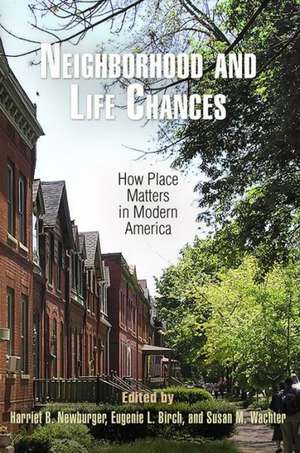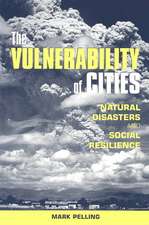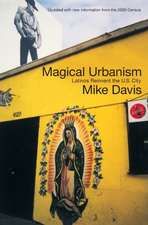Neighborhood and Life Chances – How Place Matters in Modern America: The City in the Twenty-First Century
Autor Harriet B. Newburger, Eugenie L. Birch, Susan M. Wachteren Limba Engleză Paperback – 13 mar 2013
Din seria The City in the Twenty-First Century
-
 Preț: 243.06 lei
Preț: 243.06 lei -
 Preț: 446.83 lei
Preț: 446.83 lei -
 Preț: 250.72 lei
Preț: 250.72 lei -
 Preț: 279.05 lei
Preț: 279.05 lei -
 Preț: 195.13 lei
Preț: 195.13 lei -
 Preț: 240.85 lei
Preț: 240.85 lei -
 Preț: 195.13 lei
Preț: 195.13 lei -
 Preț: 244.14 lei
Preț: 244.14 lei -
 Preț: 160.63 lei
Preț: 160.63 lei -
 Preț: 336.42 lei
Preț: 336.42 lei - 11%
 Preț: 497.99 lei
Preț: 497.99 lei -
 Preț: 236.80 lei
Preț: 236.80 lei -
 Preț: 280.39 lei
Preț: 280.39 lei - 11%
 Preț: 442.17 lei
Preț: 442.17 lei -
 Preț: 467.05 lei
Preț: 467.05 lei -
 Preț: 193.86 lei
Preț: 193.86 lei -
 Preț: 195.95 lei
Preț: 195.95 lei -
 Preț: 199.38 lei
Preț: 199.38 lei -
 Preț: 309.33 lei
Preț: 309.33 lei -
 Preț: 466.13 lei
Preț: 466.13 lei -
 Preț: 337.80 lei
Preț: 337.80 lei - 11%
 Preț: 506.29 lei
Preț: 506.29 lei -
 Preț: 399.55 lei
Preț: 399.55 lei - 11%
 Preț: 449.60 lei
Preț: 449.60 lei - 11%
 Preț: 443.59 lei
Preț: 443.59 lei - 11%
 Preț: 504.56 lei
Preț: 504.56 lei -
 Preț: 257.83 lei
Preț: 257.83 lei -
 Preț: 469.00 lei
Preț: 469.00 lei -
 Preț: 200.36 lei
Preț: 200.36 lei -
 Preț: 465.14 lei
Preț: 465.14 lei - 11%
 Preț: 445.33 lei
Preț: 445.33 lei -
 Preț: 435.69 lei
Preț: 435.69 lei - 11%
 Preț: 441.89 lei
Preț: 441.89 lei - 11%
 Preț: 471.79 lei
Preț: 471.79 lei -
 Preț: 276.52 lei
Preț: 276.52 lei - 11%
 Preț: 504.06 lei
Preț: 504.06 lei -
 Preț: 291.02 lei
Preț: 291.02 lei - 23%
 Preț: 398.54 lei
Preț: 398.54 lei - 8%
 Preț: 604.88 lei
Preț: 604.88 lei - 23%
 Preț: 491.41 lei
Preț: 491.41 lei -
 Preț: 389.50 lei
Preț: 389.50 lei - 23%
 Preț: 483.04 lei
Preț: 483.04 lei - 23%
 Preț: 428.65 lei
Preț: 428.65 lei -
 Preț: 296.80 lei
Preț: 296.80 lei - 23%
 Preț: 431.83 lei
Preț: 431.83 lei
Preț: 283.46 lei
Nou
Puncte Express: 425
Preț estimativ în valută:
54.25€ • 55.96$ • 45.91£
54.25€ • 55.96$ • 45.91£
Carte tipărită la comandă
Livrare economică 05-19 martie
Preluare comenzi: 021 569.72.76
Specificații
ISBN-13: 9780812222654
ISBN-10: 0812222652
Pagini: 392
Dimensiuni: 152 x 229 x 15 mm
Greutate: 0.64 kg
Editura: MT – University of Pennsylvania Press
Seria The City in the Twenty-First Century
ISBN-10: 0812222652
Pagini: 392
Dimensiuni: 152 x 229 x 15 mm
Greutate: 0.64 kg
Editura: MT – University of Pennsylvania Press
Seria The City in the Twenty-First Century
Cuprins
List of Abbreviations Preface -Eugenie L. Birch, Harriet B. Newburger, and Susan M. Wachter PART I. PEOPLE AND PLACES: HEALTH, EDUCATION, AND SAFETY Chapter 1. Health and Residential Location -Janet Currie Chapter 2. The Place of Race in Health Disparities: How Family Background and Neighborhood Conditions in Childhood Impact Later-Life Health -Rucker C. Johnson Chapter 3. Educational Interventions: Their Effects on the Achievement of Poor Children -Brian A. Jacob and Jens Ludwig Chapter 4. Before or After the Bell? School Context and Neighborhood Effects on Student Achievement -Paul A. Jargowsky and Mohamed El Komi Chapter 5. Neighborhoods, Social Interactions, and Crime: What Does the Evidence Show? -Steven Raphael and Michael A. Stoll Chapter 6. Daily Activities and Violence in Community Landscapes -Douglas J. Wiebe and Charles C. Branas PART II. GEOGRAPHIES OF OPPORTUNITY Chapter 7. Exploring Changes in Low-Income Neighborhoods in the 1990s -Ingrid Gould Ellen and Katherine O'Regan Chapter 8. Reinventing Older Communities Through Mixed-Income Development: What Are We Learning from Chicago's Public Housing Transformation? -Mark L. Joseph Chapter 9. Reinventing Older Communities: Does Place Matter? -Janet Rothenberg Pack PART III. MOVING PEOPLE OUT OF POVERTY Chapter 10. An Overview of Moving to Opportunity: A Random Assignment Housing Mobility Study in Five U.S. Cities -Lisa A. Gennetian, Lisa Sanbonmatsu, and Jens Ludwig Chapter 11. How Does Leaving High-Poverty Neighborhoods Affect the Employment Prospects of Low-Income Mothers and Youth? Evidence from the Moving to Opportunity Experiment -Xavier de Souza Briggs, Elizabeth Cove, Cynthia Duarte, and Margery Austin Turner Chapter 12. Teens, Mental Health, and Moving to Opportunity -Susan Clampet-Lundquist Chapter 13. Changing the Geography of Opportunity by Helping Poor Households Move Out of Concentrated Poverty: Neighborhood Effects and Policy Design -George Galster PART IV. SEGREGATION: THE POWER OF PLACE Chapter 14. Are Mixed Neighborhoods Always Unstable? Two-Sided and One-Sided Tipping -David Card, Alexandre Mas, and Jesse Rothstein Chapter 15. Preferences for Hispanic Neighborhoods -Fernando Ferreira Chapter 16. Increasing Diversity and the Future of U.S. Housing Segregation -Robert DeFina and Lance Hannon Chapter 17. Understanding Racial Segregation: What Is Known About the Effect of Housing Discrimination? -Stephen L. Ross Contents Notes Bibliography List of Contributors Index Acknowledgments
Recenzii
"Neighborhood and Life Chances is for the most part an examination of studies on changing urban communities and what happens when families move from impoverished urban neighborhoods to mixed-income communities... The variety and expertise of its contributors, coupled with a successful editing effort to maintain a unified style and coherent voice, make this book an interesting read."-Urban Geography "There is much material here that should interest those who care about American city neighborhoods as well as the experience, effects, and challenges of alleviating urban poverty."-Annals of the Association of American Geographers "Public policy interventions do not, sadly, guarantee success at work-or in life. However, Newburger, Birch, and Wachter have illuminated through well-documented research how place can dramatically impact the odds of success."-Nicolas P. Retsinas, Director, Joint Center for Housing Studies, Harvard University "This book is a fascinating compendium of insights and research about the impact of place on a wide range of human behaviors-from health to crime. If you think place matters, but you aren't sure why or how much, you need this book."-Alice M. Rivlin, Senior Fellow, The Brookings Institution "Social progress and economic opportunity in our society are national ideals but they are realistically advanced in the physical places where Americans live and work. Support for these ideals must exist in our neighborhoods, cities, and metropolitan areas. Neighborhood and Life Chances captures this reality with precision and helps us understand it so that we can act on it."-Henry Cisneros, former Secretary of the Department of Housing and Urban Development and current Executive Chairman, CityView "This collection of essays shows the historical 'people vs. places' urban policy debate to have been a false dichotomy-a difference without distinction. The contributors to this volume convincingly demonstrate that place matters, and that if our political leaders are committed to returning zip code to a metric of residential location rather than a forecast of household destiny, they will benefit from the insights presented in this rich mixture of smart, data-informed policy analysis."-Michael A. Stegman, Director of Policy and Housing, The John D. and Catherine T. MacArthur Foundation
















